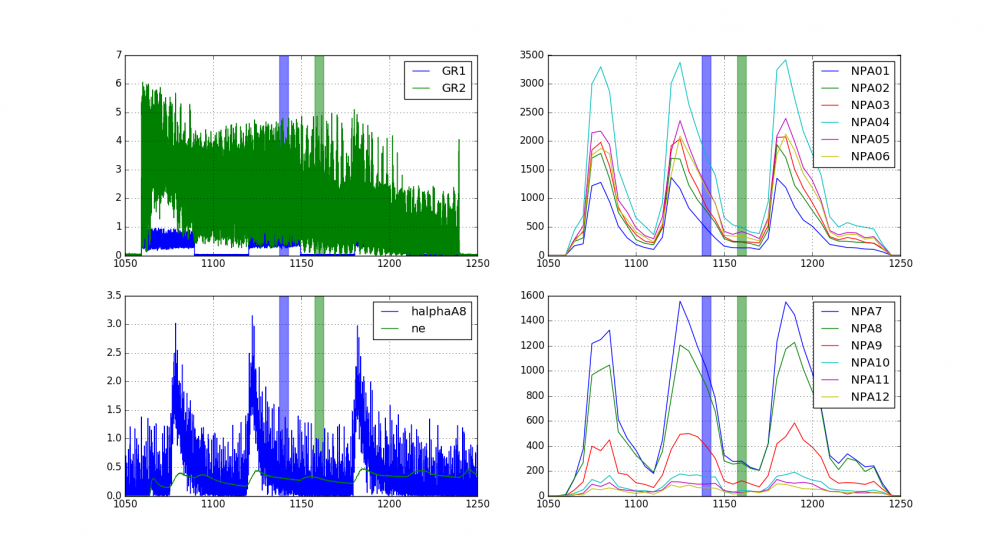TJ-II:Observation of suprathermal ions with Neutral Particle Analyzers during electron cyclotron heating in the TJ-II stellarator
Experimental campaign
2019 Spring
Proposal title
Observation of suprathermal ions with Neutral Particle Analyzers during electron cyclotron heating in the TJ-II stellarator
Name and affiliation of proponent
J.M. Fontdecaba, J. Hernández-Sánchez, N. Panadero, K.J. McCarthy Laboratorio Nacional de Fusión Ciemat, 28040 Madrid, Spain
Details of contact person at LNF (if applicable)
N/A
Description of the activity, including motivation/objectives
Suprathermal ions have been detected using optical spectroscopy techniques in TJ-II [1] but without conclusive results when using NPA diagnostics [2]. One experiment of the 2016 campaign, designed to investigate this population, consisted in operating one gyrotron along all the discharge while modulating the second gyrotron at 100% of its power [3] and changing the power deposition position in a shot-to-shot basis. No neutral beam power was injected. When both gyrotrons were on an indication of suprathermal ions was observed by the NPA diagnostic, see figure 1.
In the shot plotted in figure 1 the NPA was tuned to 200 eV in the lowest energy channel. As can be seen, the count rate in the lower energy channels (NPA 01 – NPA 06, 200 eV to 446 eV) dropped, as did the Halpha signal. In contrast, in the higher energy channels (NPA 07 – NPA 09, 540 eV to 826 eV) the count rate fell when the gyrotron was turned off. This can be a indication of the existence of suprathermal ions. The amount of suprathermal ions depends on the position of the plasma heating, so not all discharges presented the same behaviour.
A possible explanation for the suprathermal ions is a parametric decay of the injected waves [4]. In order for this to occur, a hollow profile of the density is necessary, as in TJ-II ECR heated plasmas.
In this proposal we want to reproduce the results of the 2016 campaign and in addition, change the position of the NPA in order to check the radial extension of the suprathermal ion population. Also it is intended to inject hydrogen pellets at suitable moments along the discharge in order to change the density profile, i.e. to test the validity of the assumption in [4] of the necessity of a local maximum of a non-monotonous density profile to produce the parametric decay.
New 29/01/2019 The heating position will be changed in order to find the maximum flux of suprathermal ions. Once found, a power scan will be performed to find the minimum power for triggering the production of suprathermals.
The discharges would be similar to those of the 17/11/2016 shots between 42617 and 42647 with one gyrotron heating along all the discharge and the other modulated 100 % with 20 ms period. In one of the phases with both gyrotrons on the pellet will fire so the density profile will change. The difference on the NPA signal will show the presence or not of suprathermal ion population in each phase of the discharge.
It will be necessary a full day to achieve the objectives which implies changing the heating position and the NPA position between discharges and similar plasma parameters in all discharges.
Experiment
- ECRH plasmas with two gyrotrons, one of them modulated 100%. Later a power scan.
- NPA to look for the suprathermal ions.
- Pellet injector to change the density profile.
- Thomson scattering to measure the density profiles.
- Similar plasma parameters for all the discharges.
- Density as flat as possible.
If applicable, International or National funding project or entity
N/A
Description of required resources
Required resources:
- Number of plasma discharges or days of operation: One full day.
- Essential systems:
- NPA to look for the suprathermal ions.
- Pellet injector to change the density profile.
- Thomson scattering to measure the density profiles.
- Type of plasmas (heating configuration):ECRH, one gyrotron modulated and power scan.
- Specific requirements on wall conditioning if any:
- External users: need a local computer account for data access: no
- Any external equipment to be integrated? Provide description and integration needs:
Preferred dates and degree of flexibility
Preferred dates: (dates depend on JET campaign)
March 2019.
Best dates: 10-17 March (tentative).
